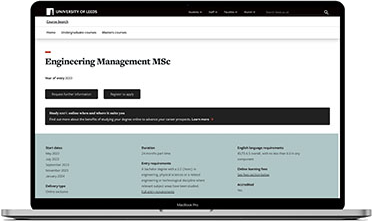3 Ways to Harness Creativity in Engineering Management
Engineering Management
Creativity in engineering is crucial to the success of projects and organisations in the industry’s ever-changing climate, and digitalisation of all industry sectors is placing a new emphasis on innovation. With new technologies such as 3D printing, robotics, artificial intelligence, and the internet of things, the only limit to what can be achieved is an engineer’s imagination.
In this blog, we assess three ways engineering managers can effectively harness creativity and innovation in the workplace.
Learn more about our Engineering Management courseWhy is creativity important in engineering?
According to the Institution of Engineering and Technology (IET), creativity is one of the most important competencies future engineers need, alongside communication. For organisations, encouraging creativity in the workplace not only develops employee engagement, productivity, and development, but can also have a positive commercial impact and create a point of differentiation from other businesses.
In a survey by global consultant AECOM, 71% of engineers said tried and tested approaches failed to meet the requirements of today’s increasingly complex infrastructure projects, emphasising the need for creativity in the industry.
What is the innovation process?
Leading technology magazine Wired define innovation as evolutionary changes to existing processes, uses, or functions, which are made better by one (or several) contributing inventions.
Expanding on this, the innovation process involves generating new, creative ideas to improve existing ways of working, helping engineers overcome any project limitations and achieve success.
“The purpose of innovation is the commercial exploitation of ideas in many forms, such as new products, services, customers, generating new markets, bigger margins, and competitive advantage”.
The 3Ps of the innovation process
When exploring how to be creative in engineering, a good place to start is with the innovation process model, no matter the role or specialism you are working in. This is typically split into three distinct areas: people, processes and product, all of which contribute to the success of an overarching project.
1. People
In engineering, ‘people’ can consist of anyone involved in a project, from team members to designers and pressure groups to clients. A range of opinions must be considered throughout the project, and these diverse views have the potential to enhance the creative output of the process.
To harness creativity in people, engineering managers must encourage open communication with all stakeholders, particularly their team members, to facilitate innovative ways of working. They can do this by listening to colleagues, encouraging them to share their ideas, and helping to bring these to life. This demonstrates the individual’s impact on the project and raises their profile at work.
Alternatively, engineering managers could propose new ways to collaborate away from typical meetings, perhaps in a different environment or during guided brainstorming sessions. These tactics will both improve creativity in engineering and the engagement and satisfaction of their people too.
2. Processes
Engineering ‘processes’ are the steps and methods taken to deliver a project, such as the research, design, concept, testing and production stages. All will influence the outcome of an engineering project, and harnessing creativity at each of these stages will enhance the final result.
Engineering leaders must strive to find new ways of conducting research, using a range of both old and new sources of inspiration which can then be integrated into the design stage. They could also seek out new software to alternate the concepts they create and refresh the type of technology they are using which can develop their methods of testing.
3. Product
While ‘process’ innovation alters the delivery method of an engineering project, ‘product’ innovation is centred around improving the characteristics of an engineered good or service.
Harnessing creativity in this area is vital for engineers to manufacture innovative products. This requires critical thinking and ingenuity around how technical specifications, components, software, or user friendliness and ergonomics can be developed to enhance the user’s experience of the product or service.
As always, the creative engineering of products need to evolve around ever-changing environmental policies. Managers can address this by using sustainable materials or finding ways to reduce emissions or wastage. This in-turn could also modify the final product design.
Why do engineering managers need to demonstrate creativity and innovation?
Despite the limitations of processes and technological standards, creativity is still vital. Engineering managers need this skill to lead innovative projects, create unique products, and position their organisation as pioneers in the industry.
Learn Innovation, Design and Creative Engineering
If you want to become a multiskilled professional at the forefront of creative engineering, consider our specialised course. Our module in Innovation, Design and Creative Engineering will broaden your understanding of innovation practice in an engineering business context, exposing you to a range of tools which can support the innovation process and deepen your understanding of the impact and challenges of delivering it.
“The content studied in my first module Innovation, Design and Creative Engineering; has proved useful as I am able to apply this knowledge directly at work, in an innovation competition we hold each year and smaller innovative projects that take place throughout the year”
Why choose Engineering Management online with the University of Leeds
The Engineering Management Masters (MSc) / Postgraduate Certificate (PGCert) at the University of Leeds is delivered 100% online, giving you the flexibility to learn whilst working. The course is specifically designed for engineers and will give you the advanced management techniques and practical skills that tomorrow’s business leaders need.
The CMI-accredited course is ideal if you are:
- In the early stages of your career and looking to fast-track your progression.
- An ambitious professional with substantial industry experience.
- Already working in engineering management or are new to a management role and looking to develop your skills.
- A busy professional and/or working abroad and unable to study full-time on-campus.
During your time on the course, you’ll learn from high-profile academics across four leading engineering schools: the School of Chemical and Process Engineering, the School of Civil Engineering, the School of Electronic and Electrical Engineering and the School of Mechanical Engineering. This unique collaboration will help you develop your working knowledge of a range of engineering specialisms.
“I highly enjoy collaborating with people from different backgrounds, and it creates an environment that promotes knowledge sharing and innovative problem-solving.”

Did you enjoy this blog? Here’s some related engineering content that you may be interested in:

Want to learn more about our online Engineering Management course?
Check out the course content and how to apply.

